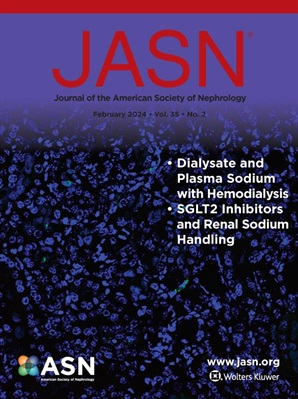通过外显子组测序系统筛查 ADTKD-MUC1 27dupC 致病变异体
IF 10.3
1区 医学
Q1 UROLOGY & NEPHROLOGY
引用次数: 0
摘要
背景MUC1基因与常染色体显性肾小管间质性肾病(ADTKD)有关,导致慢性肾脏病。目前的测序方法(如外显子组测序)很少能检测到 MUC1 致病变体,因为 MUC1 第 2 外显子中存在可变串联重复序列(VNTR)。我们在一个概念验证队列中初步验证了我们的生物信息学管道,该队列包含了33名参与者的外显子组数据,这些参与者通过快照PCR鉴定出了已知的MUC1致病变体,并由54名MUC1阴性个体作为阴性对照进行了确认。然后,我们回顾性地分析了从 2019 年 1 月到 2023 年 10 月 3512 名不明原因肾病成年参与者的外显子组测序数据。结果SharkVNTyper准确鉴定了33名参与者中32名的MUC1变体,并排除了概念验证队列中所有54名阴性对照中存在的MUC1变体(灵敏度为97%,特异性为100%)。Shark 工具与 VNTyper 的整合大大缩短了运行时间,每个样本的运行时间从 6-12 小时缩短到 5-10 分钟,既可进行回顾性分析,也可进行前瞻性分析。在回顾性队列中,SharkVNTyper 又发现了 23 例临床上未怀疑的阳性病例,这些病例在最初的外显子组分析中被遗漏;其中 18 例通过低通量快照 PCR 证实携带 MUC1 27dupC 突变。在 825 例 CKD 患者的前瞻性队列中,系统筛查发现了 13 例阳性病例,其中 12 例经 PCR 证实。总体而言,在 63 名经分子证实患有 ADTKD-MUC1 的参与者(4653 人中的 1.4%)中,有 24 人获得了全面的诊断和疾病描述。肾衰竭的中位年龄为 50 岁,38% 的人表现为双侧多发性肾囊肿,8% 的人患有早发痛风,58% 的人患有动脉高血压。本文章由计算机程序翻译,如有差异,请以英文原文为准。
Systematic Screening of ADTKD-MUC1 27dupC Pathogenic Variant through Exome Sequencing.
BACKGROUND
The MUC1 gene is associated with autosomal dominant tubulointerstitial kidney disease (ADTKD), leading to CKD. Current methods of sequencing, like exome sequencing, rarely detect MUC1 pathogenic variants because of the variable number of tandem repeats (VNTR) in MUC1 exon2. We demonstrated that combining fast read filtering with a sensitive VNTR genotyping strategy enables systematic screening of 27dupC pathogenic MUC1 variant from exome data.
METHODS
We initially validated our bioinformatics pipeline in a proof-of-concept cohort incorporating exome data from 33 participants with a known MUC1 pathogenic variant identified by Snapshot PCR and confirmed by 54 MUC1-negative individuals for negative control. We then retrospectively analyzed exome sequencing data from January 2019 to October 2023 from 3512 adult participants with nephropathy of unknown origin. Finally, we prospectively validated our pipeline in 825 additional participants enrolled from November 2023.
RESULTS
SharkVNTyper accurately identified MUC1 variants in 32 out of 33 participants and excluded its presence in all the 54 negative controls in the proof-of-concept cohort (sensitivity of 97%, specificity of 100%). Integration of Shark tool with VNTyper significantly reduced running time from 6-12 hours to 5-10 minutes per sample, allowing both retrospective and prospective analysis. In the retrospective cohort, SharkVNTyper identified 23 additional positive cases that were not suspected clinically and had been missed in the initial exome analysis; 18 of these cases were confirmed as carrying the MUC1 27dupC mutation by low-throughput Snapshot PCR. In the prospective cohort of 825 CKD cases, systematic screening discovered 13 positive cases, with 12 confirmed by PCR. Overall, of 63 participants (1.4% of 4653) with molecularly confirmed ADTKD-MUC1, comprehensive diagnoses and descriptions of the disease were available for 24 participants. Median age of kidney failure was 50 years, 38% exhibited bilateral multiple kidney cysts, 8% had early-onset gout, and 58% had arterial hypertension.
CONCLUSIONS
SharkVNTyper enables the analysis of highly repeated regions, such as the MUC1 VNTR, and facilitates the systematic screening of ADTKD-MUC1 from exome data, fostering 27dupC variation identification.
求助全文
通过发布文献求助,成功后即可免费获取论文全文。
去求助
来源期刊
CiteScore
22.40
自引率
2.90%
发文量
492
审稿时长
3-8 weeks
期刊介绍:
The Journal of the American Society of Nephrology (JASN) stands as the preeminent kidney journal globally, offering an exceptional synthesis of cutting-edge basic research, clinical epidemiology, meta-analysis, and relevant editorial content. Representing a comprehensive resource, JASN encompasses clinical research, editorials distilling key findings, perspectives, and timely reviews.
Editorials are skillfully crafted to elucidate the essential insights of the parent article, while JASN actively encourages the submission of Letters to the Editor discussing recently published articles. The reviews featured in JASN are consistently erudite and comprehensive, providing thorough coverage of respective fields. Since its inception in July 1990, JASN has been a monthly publication.
JASN publishes original research reports and editorial content across a spectrum of basic and clinical science relevant to the broad discipline of nephrology. Topics covered include renal cell biology, developmental biology of the kidney, genetics of kidney disease, cell and transport physiology, hemodynamics and vascular regulation, mechanisms of blood pressure regulation, renal immunology, kidney pathology, pathophysiology of kidney diseases, nephrolithiasis, clinical nephrology (including dialysis and transplantation), and hypertension. Furthermore, articles addressing healthcare policy and care delivery issues relevant to nephrology are warmly welcomed.

 求助内容:
求助内容: 应助结果提醒方式:
应助结果提醒方式:


